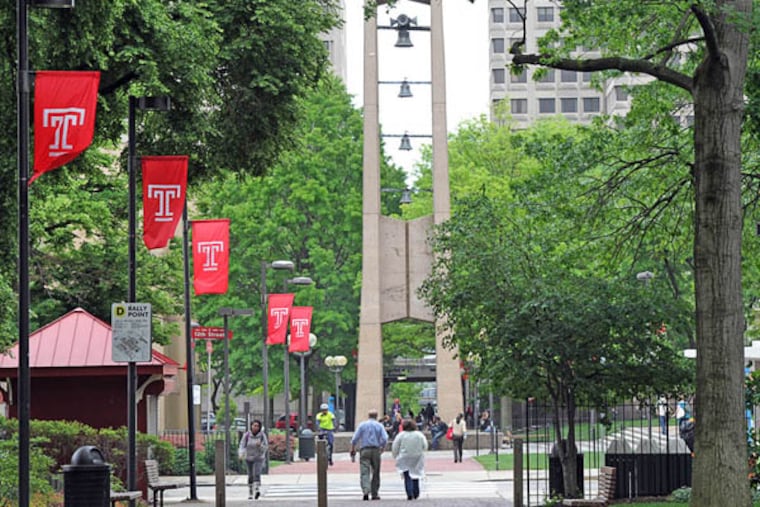Mumps outbreak at Temple adds to growing number of cases on college campus
The news is resurfacing concerns that the mumps vaccine may lose strength over time.

At least four students at Temple University have the mumps, making it the latest in a growing number of colleges reporting incidents in recent years, and resurfacing concerns that the mumps vaccine may lose strength over time.
On Thursday night, Temple sent an email alerting 40,000 students and several thousand faculty and staff that the Philadelphia Department of Public Health had verified four cases of the infectious disease on campus.
The health department is continuing to investigate, and the university believes there could be more cases, said Ray Betzner, a Temple spokesperson.
There are no other known cases at local schools or colleges, the health department said.
Mumps is a contagious viral disease. Common symptoms include swollen salivary glands, fever, headache, muscle aches, and loss of appetite. While serious complications are rare, especially in people who were vaccinated as children, mumps can cause inflammation of the brain, deafness, or sterility.
Similarly to the flu, there is no treatment. But for most people, symptoms fade after 10 days.
People who think they may be sick should stay home to limit the spread of the disease, said Dana Perella, manager of the health department’s acute communicable disease program.
At Temple, news of the four cases came just before the start of spring break, which begins Friday.
“There’s a potential for students to scatter,” Betzner said.
That’s why the university tried to get information out to students as soon as possible, he said. Families can decide if it’s best for students to stay on campus or go home. (For family members with autoimmune disorders, exposure to a student with mumps could cause complications.)
According to the Pennsylvania Department of Health, three cases of mumps have been reported across the state this year.
Around this time last year, the Philadelphia region saw an outbreak of about 20 cases of mumps linked to a social dance event.
Overall, mumps cases in the United States have declined 99 percent since the vaccine was introduced in 1967.
But in recent years, there’s been a resurgence, with the number of reported cases growing from 229 in 2012 to 6,366 in 2016.
And most are taking place on college campuses. In 2016, outbreaks at universities in Iowa and Illinois affected several hundred students. In 2017, Pennsylvania State University had an outbreak of more than 40 cases.
Part of the risk comes from the college environment, experts say. Students live in close quarters, spend extended periods of time together, and are more likely to exchange saliva through kissing or sharing food and drink. That makes it easier for the virus to spread.
But college students are also a highly vaccinated population, said Paul Offit, director of the Vaccine Education Center and a professor of pediatrics at Children’s Hospital of Philadelphia. In Pennsylvania, children are required to have the MMR vaccine before entering school, though they can get exemptions for medical or religious reasons.
“Unlike with measles outbreaks, where most of the people are unvaccinated, in these cases, more than half have been vaccinated,” Offit said.
Health officials did not say if the students infected at Temple had been vaccinated.
The issue is that the vaccine may become less effective over time, Offit said.
When the MMR vaccine, which protects against mumps, measles, and rubella, was introduced, only one dose was recommended. But then doctors noticed children were getting mumps 10 years later, Offit said. So a second dose was added.
Today the CDC recommends children get two doses of the MMR vaccine: the first at 12 to 15 months old and the second at 4 to 6 years old. The vaccine is 88 percent effective when someone gets two doses.
But there is evidence that its power may fade after 10 years — around the time students are ready for college.
Researchers at Harvard University have suggested a booster shot for mumps might help protect students as they enter college. Offit also said it would be a reasonable recommendation for all students.
As of now, the CDC only recommends a third dose during an outbreak situation, like the one at Temple.
A Temple spokesperson said the vaccine is available on campus for students who have been in close contact with someone who has experienced symptoms.
As a matter of policy, Temple recommends, but does not require, immunizations for admitted and enrolled students.
Some other local universities, like Drexel and Penn State, require incoming students have two doses of the MMR vaccine.
“The vaccine is still our best prevention tool,” said Kristen Feemster, medical director of the Philadelphia health department’s acute communicable disease and immunization programs. “The most important thing students can do now is make sure they’re up to date on their MMR shots.”